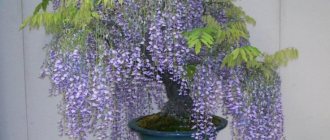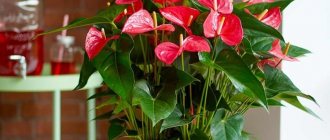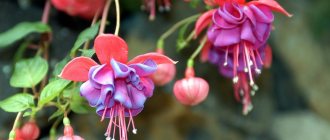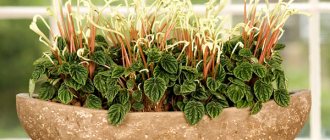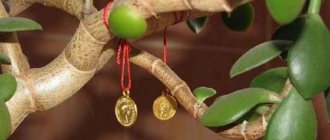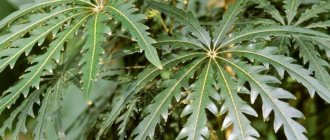The tetrastigma plant belongs to the grape family. The genus includes about 100 species that can be found in the wild in northern Australia and southern Asia. In mid-latitudes it is grown indoors and is called “house grape”.
Tetrastigma is a large vine with lobed leaves. Under natural conditions, its length can reach more than 50 meters. Small flowers have no decorative value. It is very easy to grow indoors and can grow incredibly long, but is usually pruned to around 200-300cm. Tetrastigma is a very fast growing plant and can reach a length of around 100cm in 12 months (depending on conditions).
Tetrastigma: description and characteristics
Tetrastigma: photo
In today's article we will tell you about an amazing plant, tetrastigma. This culture belongs to the Vinogradovs. There are more than 100 species in the genus; in its natural habitat, tetrastigma is found on different continents. However, under indoor conditions, this plant is very often grown as home grapes. Therefore, you can easily grow this beautiful vine in your apartment. The foliage of Tetrastigma is quite large and lobed in shape. In its natural habitat, this plant is found, as we noted earlier, on different continents. Moreover, it is important to note that in natural conditions it grows very intensively. The shoots reach tens of meters in length. Flowers are not particularly valued; indoor plants are grown to decorate your home with exotic vines. It is best, however, to shorten the shoots to a meter or 2-3 meters. Tetrastigma is restored very quickly, therefore, under favorable growing conditions, these vines can increase in length by almost 1 m per year.
3.Varieties:
3.1. Tetrastigma voinierianum
A fast-growing evergreen vine with woody stems up to 9 m long. The leaves are dark green, glossy, complex and consist of 3 to 5 broadly lanceolate segments. The leaf blades have large teeth along the edges and are often lighter in color on the lower surface. Young shoots and the lower surface of the leaves are covered with small, delicate pubescence. Small greenish flowers appear in early summer in a branched inflorescence called a raceme. Flowering is not of particular interest.
This variety is most often found in indoor culture.
↑ Up,
Tetrastigma: care at home
Caring for this crop is easy. Therefore, even a novice gardener will be able to grow a whole greenhouse of tetrastigma at home. Lianas are considered unpretentious, but you will still need to follow certain agrotechnical rules. This culture is considered light-loving, so it is better to leave pots with plants on windowsills. But remember, despite the light-loving nature, sunlight should be diffused. Direct sunlight should not fall on the foliage, otherwise the plant may get burned. If we talk about temperature conditions, this plant is also classified as heat-loving. The air temperature should not be lower than + 23 degrees. However, this only applies to the spring-summer season. In winter, it is better to keep the plant cool, but there are also limitations here; the room temperature should not fall below + 12 degrees. If the temperature is too low, the leaves of the plants may fall off. It is also believed that this culture does not like drafts, so choose the right place where it is best to place the pot. The air humidity in the room should not be very high; usually, if you are comfortable in the living room, then the plant will be just as comfortable. However, it is still recommended to spray the foliage once every 6-7 days with a spray bottle, this way you will knock dust off the leaf plates and also moisten the shoots. However, this is done only when the room is warm; during a cool winter, it is not recommended to spray the leaves. If we talk about the watering regime, then you need to adhere to the following rule: the earthen lump in the pot should not dry out. It is best to water the plant about 2 times every 6-7 days in spring and summer. But during wintering, the watering regime will need to be adjusted; it is best to water the plants during this period once every 2 weeks. The soil in the pot should remain slightly moist, but do not overdo it with watering; in winter, excess moisture negatively affects the development of this crop. In order to plant indoor tetrastigma grapes, you will need to pour loose soil into the pot; it must be enriched with nutrients. If we talk about the level of acidity, then the soil should be either slightly acidic or neutral. You can easily prepare the soil mixture yourself. To do this, you will need to mix garden, turf and deciduous soil, add a little fertilizer there, lay drainage at the bottom of the container, make a hole in the pot, and pour the soil mixture into the container. Now you can plant. It is recommended to feed this crop quite often; this is done especially intensively in the summer and spring. Fertilizing is usually applied to the soil once every 2 weeks. If indoor Tetrastigma grapes develop very intensively, then the crop will need to be fed more often; experienced gardeners apply fertilizer to the pot once a week. At the same time, it is important to alternate organic and mineral fertilizers; the ready-made mixture can be purchased at a farm store.
Difficulties in growing
Despite the unpretentiousness of the plant, some difficulties may arise during cultivation.
Most of them are easy to overcome if you pay attention to the violation in time:
- Elongated shoots . This symptom is a consequence of severe darkness, which can be corrected by moving the flowerpot closer to the light source. In this case, it is better to trim the vines.
- Brownish spots and dried edges of leaves. The cause is most likely too intense light, which led to a burn. It is better to move the pot with the plant to a darker place and remove the affected foliage.
- Brown spots on foliage. If the leaf lobes fall off, we can talk about the effects of low temperature. In this case, it is necessary to increase the heating of the room.
- Yellow leaves and cobwebs on the inside. This symptom indicates a spider mite infestation. Damaged parts must be cleared of cobwebs and treated with an insecticide.
- Brown inclusions at the bottom of the leaves and a sticky coating. The reason lies in the attack of the scale insect. The plant can be cured using insecticides.
- A coating similar to cotton wool in the sinuses. This means a mealybug infestation. As in previous cases, insecticides should be used against pests.
- White spots and sticky coating on the inside of the foliage and the presence of white midges. The appearance of these symptoms indicates the proliferation of whiteflies. Leaves can be wiped with soapy water. If this folk method does not help, systemic treatment with insecticides should be carried out.
Tetrastigma is a beautiful plant that does not require much care. If you approach the cultivation of home grapes correctly, they will delight their owners with luxurious vines for a long time.
Tetrastigma: transplanting and pruning
Tetrastigma: photo
It is believed that at first, tetrastigma vines grow very intensively, so the plants will need to be replanted, imagine, more than once a year. But mature bushes will need to be replanted less frequently, usually once every few years. It is believed that the tetrastigma plant tolerates this procedure well, but you should always choose a new pot, so that it is several times larger than the old one; when you transplant an adult bush into a real tub, quite large and voluminous, then do not replant the plant in the future need to. In order for indoor tetrastigma grapes to grow and develop intensively, simply periodically change the top layer of soil, and also add fresh fertilizer to the soil. But cutting off the shoots is not recommended at all. But if you want to form a crown, then rest assured, this plant tolerates this procedure normally. However, experienced gardeners recommend pruning the vines when the bush reaches the desired size; this is done in order to restrain its development in the future. As you remember, in its natural habitat this bush can reach tens of meters in length; you must agree that even the most avid gardener does not want to turn his apartment into a jungle. That is why it is recommended to trim the bushes. However, it is undesirable to touch young foliage with your hands, much less cut it off. Otherwise, the shoots may disappear altogether. It is recommended to install supports near mature bushes, but it is not advisable to do this in advance.
Top dressing
Tetrastigma Voinier responds well to feeding. And it is advisable to fertilize homemade grapes once every two weeks from spring to autumn. For these purposes, use complex mineral compositions. And also sometimes pamper the vine with organic matter, for example, green fertilizer. In winter, the plant enters a dormant period; at this time it does not need feeding.
Indoor grapes tetrastigma: reproduction
Most often, the tetrastigma liana is propagated by cuttings; this is quite easy and simple to do. In order to select the desired shoot, use the tip of the shoot. Each cutting must have a pair of leaves, as well as an active bud. From below, it is recommended to treat the cuttings with a growth stimulator so that the root system develops more intensively. In order for the cuttings to take root, they will need to be placed in a specially prepared soil mixture with the addition of peat and sand. You can simply put the cuttings in water, and thus the root system will form. In order for the shoots to take root faster, cover the top of the container with the cuttings with glass or film. This is done in order to create a favorable microclimate. When the shoots take root, they can be planted in separate containers. The soil mixture should be the same as for replanting plants. It is recommended to add a little thorn and deciduous soil to the garden soil. Usually cuttings take root fairly quickly.
Temperature
This ornamental plant for the home is a heat-loving crop. And from spring to autumn it is advisable to maintain the room temperature within +23...+27 °C. In summer, you can take the plant out onto the balcony or into the garden, but you should choose a place for it where direct rays of the sun or sharp gusts of wind do not reach.
In winter, grapes require cooler conditions (+15...+17 °C). But it is important to remember that a drop in temperature to +12 °C will become critical for the flower. And in such cold weather he will quickly freeze and die.
Pests and diseases
Tetrastigma plant: photo
Tetrastigma flower is considered a fairly stable crop. Therefore, pests and diseases are not terrible for this plant. But if you do not care for your houseplant as it should, then you may well encounter various difficulties and problems. The air humidity in the room must be at an average level. If the humidity is low, then spider mites may well appear on the bush. As you know, these harmful insects drink juice from the leaves, which means that over time the shoots and leaves die without moisture and nutrients. If you notice thin cobwebs and a powdery coating on the leaf plates, this indicates the appearance of these insects. However, very often a regular shower helps to cope with these pests. The water must be warm, but if this does not help, you can treat the foliage and shoots of the plant with insecticides. Usually after such “chemistry” all insects disappear. Another pest that often settles on the plant is the mealybug. If you notice that a whitish coating has appeared on the foliage, this indicates the appearance of this insect. Wipe the leaves with a slightly dampened cloth, removing this plaque; after this, it is advisable to spray the plants with insecticides; you can also use traditional methods, for example, treat the foliage with garlic tincture. If you violate the rules of agricultural technology, then other problems may arise for this crop. If you notice that the stems have begun to stretch, this indicates poor lighting in the room. But if the light, on the contrary, is too bright, then very often yellow spots begin to form on the grape leaves. This sign also often indicates that you are using fairly hard water for irrigation. If the plant is exposed to low temperatures, then black spots may form on the foliage and shoots.
Main types
There are 3 main types of this plant.
- Tetrastigma of Voinier . Originally it was an inhabitant of tropical climates. It has impressive dimensions. It is distinguished by the presence of a brown fluff on the back of the leaf. The interior of the foliage has a brilliant emerald tint.
- Tetrastigma lancentae . Representatives of this species have elongated leaf lobes and strongly depressed veins. Because of its appearance it is often called a “fish”.
- Tetrastigma obovate . The leaves of plants belonging to this species have the shape of an inverse egg, which determines the name of the variety. The blunt end is located at the outer end of the leaf, while the point of attachment to the stem is pointed.
